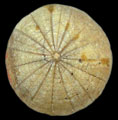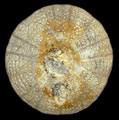The Echinoid Directory
Contributed by Jenna Sullivan, April 2007
Hawkinsia Lambert, 1928, p. 21
[Nom. cor. for Hawkensia Lambert, 1928, p. 21 by Jeannet 1937, p. 581 ]
| Diagnostic Features | Like Lanieria lanieri but with ambulacral pores in the inframarginal region simple and directly superimposed; ambulacra consist of primaries from the apex to a point very near to the peristome. (Hawkins, 1913, p. 203)
|
|---|---|
| Distribution | Upper Cretaceous of Cuba and North Africa. |
| Name gender | feminine |
| Type | Holectypus cubae Hawkins, 1913, by original designation. Holotype: Natural History Museum E11516. |
| Species Included |
|
| Classification and/or Status | Holectypoida, Holectypidae Subjective junior synonym of Metholectypus. |
| Remarks | Other than being slightly more conical in shape, this material closely resembles the unique specimen from the same locality and horizon described by Hawkins (1913) as Metholectypus trechmani. It is similar to Lanieria lanieri, however in L. lanieri, the first sign of "plate crushing" occurs further down from the apex. (Hawkins, 1913, p. 203). Lambert (1928) originally spelt the name Hawkensia and this error was corrected by Jeannet (1937) Hawkins, H. L. 1913. On Lanieria, Duncan, a remarkable genus of the Holectypoida; with a preliminary note on the tendencies of Echinoid Evolution. Geological Magazine dec. V, 10(4): 199-205. Jeannet, A. 1937. Encore Lanieria lanieri (d'Orb) Cotteau. Observaions nouvelles. Eclogae geologicae Helvetica 29, 581-598. Lambert, J. 1928. Sur deux echinides fossiles de Cuba. Bulletin de la Societe geologique de France 4 serie 28, 19-21. |



